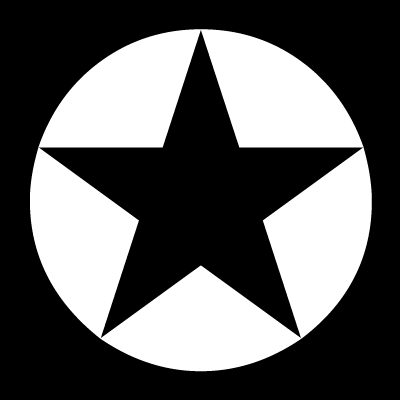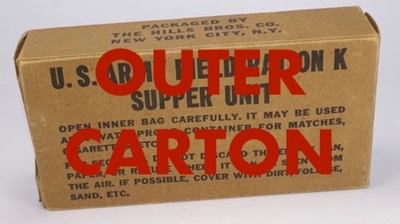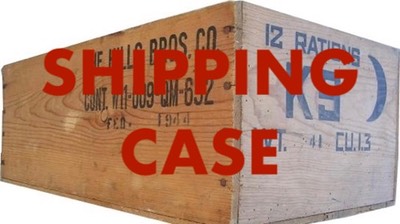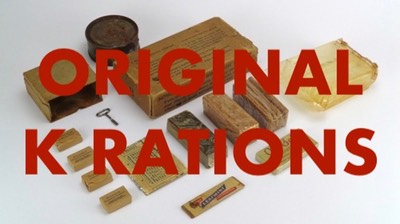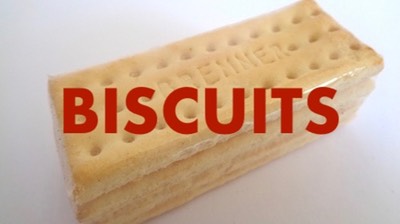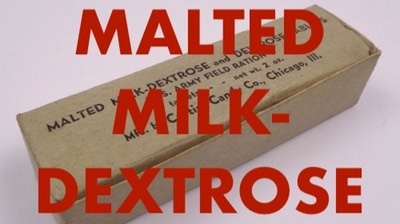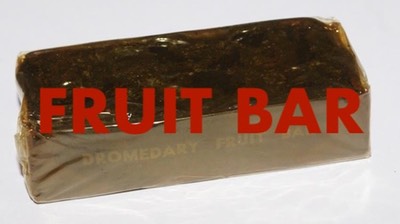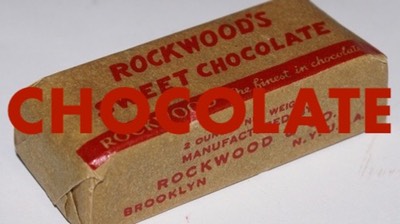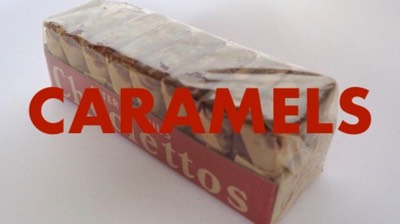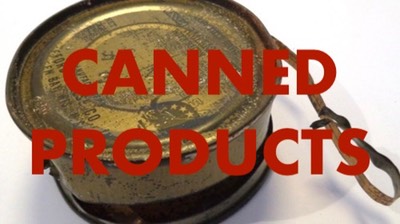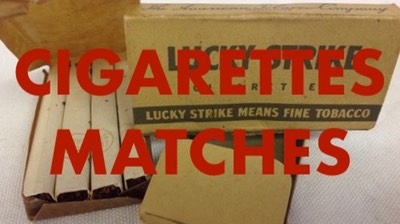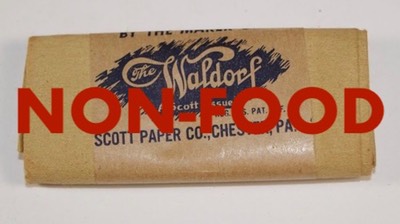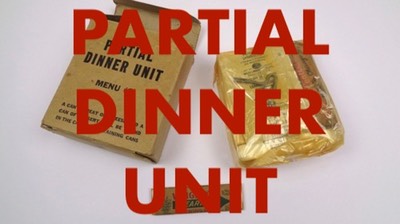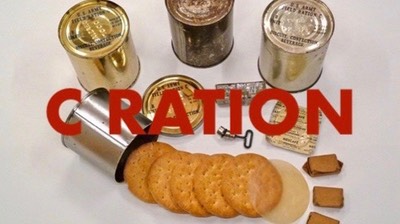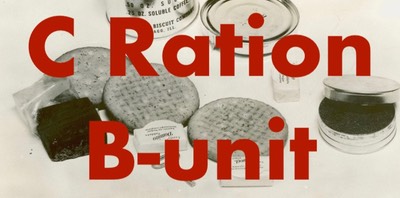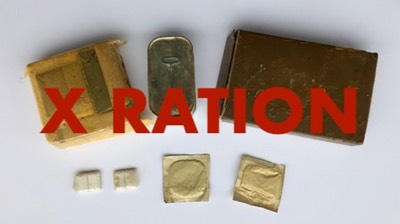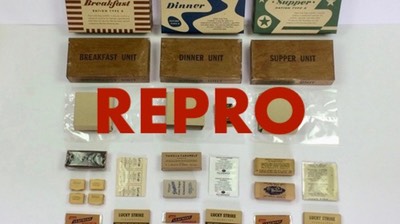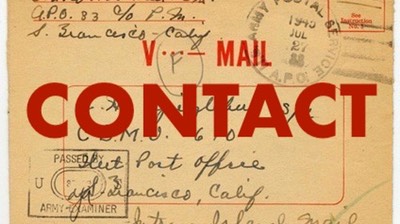
We used K Ration lemon powder dissolved in buckets of water for scrubbing the floor when we were living in buildings, and it worked out exceptionally well, cutting dirt spots and more or less bleaching the wooden floors.
(Although the package that held the beverage powder can also be called a sachet, I use the same name that is used in the official specifications: envelope.)
With the experimental K Ration two tablets of soluble coffee (aluminum foil packaged), a tube of bouillon paste, and an envelope of lemon powder drink was furnished as a beverage for each meal respectively. Soon the lemon powder was switched to the Dinner unit and the bouillon (now a powder packed in a cellophane envelope) was switched to the Supper unit.

Early experimental K Ration Dinner unit showing the tube of bouillon paste. Note the thick Defence biscuits.
From the beginning on the coffee powder was sealed in an aluminum envelope because, due to its hygroscopic qualities, it was not feasable to package it in just a cellophane envelope.
The fruit juice powder and bouillon powder were sealed in a clear cellophane envelope with instruction printed in black or white ink on the envelope. When the restrictions on the use of aluminum was lifted all beverage powders were to be sealed in a cellophane laminated to aluminum foil style envelope not exceeding 3 by 2 1/4 inch, later changed to 3 1/8 by 2 3/8 inch.
The cellophane was to be printed with a dull sand color (in practice an off-white) with the text printed in either dark blue or black.
Coffee
With the official adoption of the K Ration the Breakfast unit contained one aluminum foil envelope of 5 grams soluble coffee product.

Early aluminum foil envelope of soluble coffee product manufactured by the American Dietaids Co. Later they branded their coffee product under the name of Kup Kafay.

Another early aluminum foil packed soluble coffee product. (photo: 1944Supply)

The envelope of Kup Kafey soluble coffee product was only printed on the front, the back of the envelope is left blank.
The original pure soluble coffee was not popular with the soldiers testing the ration and was considered being replaced by a fruit powder or a chocolate drink. An alternative was found when Nestlé introduced its Nescafé soluble coffee. This was a soluble coffee with maltose, dextrine and dextrose added for a milder flavor. This coffee product was already included in the C Ration and well liked by the men during field tests.

Front and back of a Nescafé envelope. This was the same type of envelope that was used with the C Ration. These came from an early 1945 Breakfast unit.

Another square envelope also packaged by Miles but containing a soluble coffee product produced by Barrington Hall this time. The back carries the same instruction label as the package shown left in the previous picture. (photo: 1944Supply)

Alternative packaging for the Nescafé soluble coffee product. (photo: 1944Supply)
One envelope of 5 grams was included in the Breakfast unit untill the fall of 1944, when an additional envelope (also containing 5 grams) was added to the Breakfast unit and another envelope with 5 grams of soluble coffee product was included in the Supper unit supplementing the bouillon powder. Although no extra sugar was provided in the Breakfast unit, a 23-grams package of sugar was included in the Supper unit for use with the coffee.

Sol Cafe soluble coffee product. (photo: 1944Supply)

Note that the Nestlé, Great Star Co. and the General Food Corp. soluble coffee products are all packaged by Henry Heide, Inc. All have the same instructions on the back (shown below).

Lemonade
Dinner came with a Lemon juice powder in a cellophane envelope containing seven grams of synthetic crystals. Although praised during early tests, mainly because it could be made by just adding cold clean water, the lemonade turned out very unpopular with the troops in the field. It was usually referred to as battery acid. It found other uses as well:
"We used K Ration lemon powder dissolved in buckets of water for scrubbing the floor when we were living in buildings, and it worked out exceptionally well, cutting dirt spots and more or less bleaching the wooden floors."

An early cellophane envelope containing Lemonade powder.
After 75 years the white synthetic lemon crystals caked to a dark brown solid mass and the cellophane has been attacked by weevils. Shown here is the back with its center seam, the front is devoid of any printed instructions which is not uncommon for early production. These envelopes were also used in some B-units of the C Ration.

An early cellophane envelope containg Lemon juice powder. Originally the powder would have been white, but having discoloured over the years to brown.
Note that the label mentions that it is produced for both the K and C Rations.
Note that the weight is given in ounces and grams, 1/4 and 7 respectively.

An alternative packaging for the Lemon Juice powder (Beverage Powder Lemon Flavor) was a lined kraft paper envelope shown here. This envelope came from a Type I Dinner unit. This style of envelope was also used in the early production of the 5-in1 Ration.
Again, the weight is given in ounces and grams.
Although unpopular and substitution of a cacao drink was recommended, the fruit juice powder was deemed necessary because it was the only means of providing a daily need of vitamin C (60 milligrams of ascorbic acid) with the ration.
With the availability of aluminum, the preferred packaging became the cellophane laminated to aluminum foil envelope. Due to shortages, however, the clear cellphane envelopes were still produced and included till late in the war.

A mid war envelope containing 7 grams (1/4 ounce) of a synthetic Lemon juice powder.
When the Lemon juice powder was developed and tested in the laboratory, where there was acces to clear, clean water, it was very well received by the officers testing it. When tested in mess halls it was found acceptable by the men as well. The only mild complain was that it wasn't carbonated.
One of the reasons of its unpopularity is that in the field soldiers needed to use purified water. The chlorinated water made the lemonade taste horrible. As a side effect, the lemon crystals neutralized the purifying properties of the Halazone tablets if the lemon powder was added too quickly after purifying the water.
While the Lemon juice powder was tested and accepted, an alternative was also developed. An orange flavoured fruit juice powder was introduced later for use with the K (and C) Rations and the instructions on the outer carton would read "Lemonade or Orange powder”
Although I have found only one reference to specifications dated 6 December 1943, the Orange juice powder was included earlier than this date in rations. It is fair to say that the Orange juice powder started to show up in the K Rations from mid 1943 with the introduction of the Type IIIa K Ration.

Although the aluminum foil envelopes were the preferred packaging, cellophane was used throughout the war due to inadequate production of the foil type. Here is a cellophane envelope shown with the new "morale" packaging. Although hard to make out in the photo, it apears to be "Orange Juice Powder Synthetic".
In 1945 the Lemon juice powder was deleted and only Orange or Grape juice powder (or coffee) was included in the Dinner unit as a beverage. Grape juice powder was already introduced with the 5-in-1 Ration in 1942 and later in the 10-in-1 Ration in 1943.
The September 1945 specifications mentions either Orange juice, Grape juice, or soluble coffee product as the beverage component. (The specific beverage was specified in the contract awarded to the main contractor.)

An envelope containing 7 grams of Grape juice powder made by SunWay Fruit Products.

Although the early clear cellophane envelope was to be replaced by the cellophane/ aluminum foil laminate when aluminum became available, the clear cellophane envelopes still can be seen used as late as 1945.
The fruit juice powders were included in practically all rations. (Not only in the C, K and 10-in-1 field rations, but also in the "Aid Station Beverage Pack", bailout rations and others.) The enormous demand for the aluminum foil envelopes was more than the manufacturers could produce, so the use of the cellophane envelopes was continued as an alternative packaging.

Two Orange Juice Powder Synthetic envelopes. It appears that the listing of the ingredients was not mandatory. Below is shown the backs of the envelopes carrying the instructions for preparation.

Bouillon
With the experimental K Ration the bouillon included was a paste packaged in a tin tube. It was discovered that the salt particles pinholed the tin container rendering the bouillon paste useless. Bouillon cubes were tried as an alternative, but it was found that the cubes didn’t as readily dissolve in cold water as they did in hot water. Since hot water wasn’t ussually available to the frontline soldier this was considdered a problem.
A new bouillon drink was developed in a granulated powder form. Ten grams of bouillon powder was packed in a cellophane envelope and was issued with the Supper unit. Companies producing the bouillon powder were encouraged to come up with a formula of their own, so as to add a little variety. The formula had to be submitted first to the Army for approval, of course.
Again, later, the bouillon powder was packed in the aluminum foil packaging, although an envelope made of grease-proof paper, like with the lemonade powder, has been found in a "morale" box K Ration.

An early Bouillon clear cellophane envelope produced by the Miles Laboratories Inc., but packaged by the McKay-Davis company.
The label reads "Component of U.S. Army Ration K and C". At the time of it's inclusion in the K Ration it was also considered as a component for the C Ration's Supper unit, but ultimately a cocoa beverage was included in the C Ration. (photo: 1944Supply)
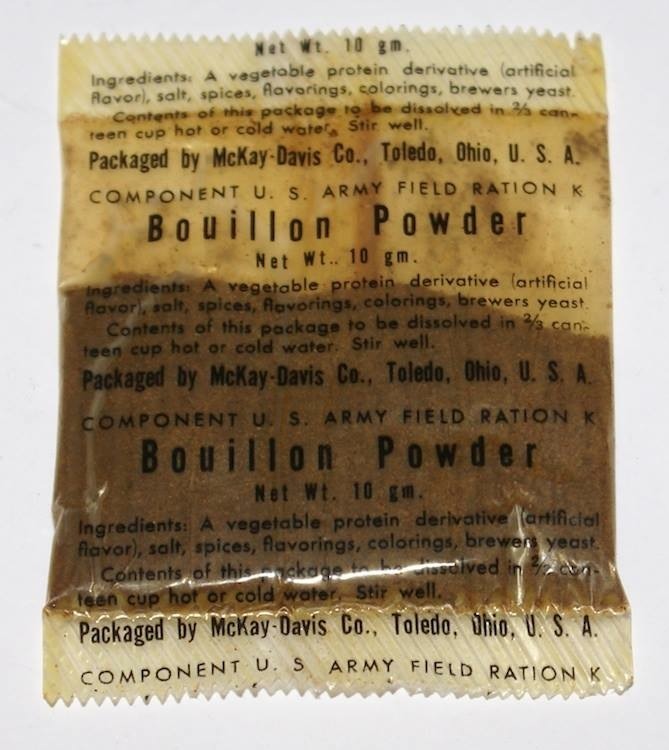
Bouillon powder made by the McKay-Davis Company for the K Ration. (photo: 1944Supply)

Another cellophane sealed bouillon powder packaged by Block Drug Co.,Inc.

Bouillon powder packaged in a grease-proof/glassine paper envelope from a late 1944 Supper unit. Note that this one is also packaged by the Henry Heide Inc. (photo: 1944Supply)

A clear cellophane envelope and an aluminum foil envelope with bouillon powder, both manufactured and packaged by the McKay-Davis Co.
